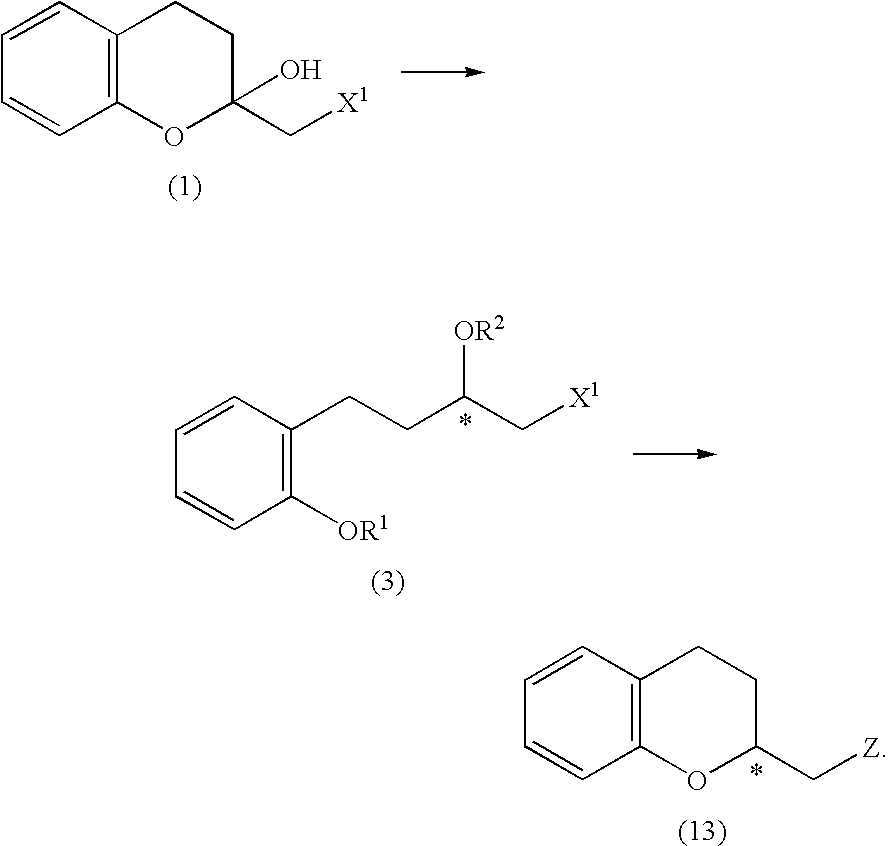Process for producing optically active chroman derivative and intermediate
a technology of optically active chroman and intermediate, which is applied in the preparation of sulfonic acid esters, biocide, animal repellents, etc., can solve the problems of low yield and efficiency, long and complicated production process, and complex production process, etc., and achieves high yield and efficiency. high, efficient production
- Summary
- Abstract
- Description
- Claims
- Application Information
AI Technical Summary
Benefits of technology
Problems solved by technology
Method used
Image
Examples
example 2
(2S)-1-Chloro-4-(2-hydroxyphenyl)butan-2-ol
5 ml of a liquid medium (pH: 7.0) containing 40 g of glucose, 3 g of yeast extract, 6.5 g of diammonium hydrogen phosphate, 1 g of dipotassium hydrogen-phosphate, 0.8 g of magnesium sulfate heptahydrate, 60 mg of zinc sulfate heptahydrate, 90 mg of iron sulfate heptahydrate, 5 mg of copper sulfate pentahydrate, 10 mg of manganese sulfate tetrahydrate, and 100 mg of sodium chloride per liter was distributed in 5 ml portions into a large size test tube and was steam-sterilized at 120° C. for 20 minutes. The liquid broth portion was aseptically inoculated with a loopful of Candida magnoliae IF0705, and was incubated with shaking at 30° C. for 24 hours. Upon completion of the incubation, the cells were collected from the culture by centrifugation and were suspended in 0.5 ml of a 100 mM phosphate buffer solution (pH: 6.5) containing 40 mg of glucose. To the suspension, 5 mg of 1-chloromethyl-1-hydroxychroman was added, and the reaction was ...
example 3
(2S)-1-Chloro-4-(2-hydroxyphenyl)butan-2-ol
The same reaction as in EXAMPLE 2 was carried out using a culture broth of Candida maris IF010003 prepared as in EXAMPLE 2 with the same culture medium. As a result, 0.8 mg of (2S)-1-chloro-4-(2-hydroxyphenyl)butan-2-ol (optical purity: 99.5% ee) was obtained. EXAMPLE 4 (2S)-1-Chloro-4-(2-hydroxyphenyl)butan-2-ol
A 50 ml of a liquid broth (pH 7.0) containing 16 g of bacto-tryptone, 10 g of yeast extract, and 5 g of sodium chloride per liter was placed in a 500 ml Sakaguchi flask and steam-sterilized at 120° C. for 20 minutes. The liquid broth was asceptically inoculated with a loopful of Escherichia coli HB101 (pNTS1G), accession number FERM BP05835 (deposited with International Patent Organism Depositary, National Institute of Advanced Industrial Science and Technology, Tsukuba Central 6, 1-1-1 Higashi, Tsukuba, Ibaraki, Japan, since Feb. 24, 1997). After 24 hours of culture with shaking at 37° C., the culture broth was centrifuged to ...
example 5
(2S)-1-Chloro-4-(2-hydroxyphenyl)butan-2-ol
500 mg of 1-chloromethyl-1-hydroxychroman, 550 mg of glucose, and 20 mg of NADP were added to 50 ml of a suspension of Escherichia coli HB101 (pNTFPG), accession number FERM BP-7117 (deposited with International Patent Organism Depositary, National Institute of Advanced Industrial Science and Technology, Tsukuba Central 6, 1-1-1 Higashi, Tsukuba, Ibaraki, Japan, since Apr. 11, 2000) prepared as in EXAMPLE 2 using the same culture medium. The mixture was allowed to react at 30° C. for 48 hours with stirring while maintaining pH of the reaction mixture at 6.5 using a 5M sodium hydroxide aqueous solution. Subsequently, 480 mg of (2S)-1-chloro-4-(2-hydroxyphenyl)butan-2-ol (yield: 95%) was obtained by the same process as in EXAMPLE 3. The optical purity determined by the process described in EXAMPLE 1 was 99.5% ee.
PUM
| Property | Measurement | Unit |
|---|---|---|
| Optical activity | aaaaa | aaaaa |
Abstract
Description
Claims
Application Information
 Login to View More
Login to View More - R&D
- Intellectual Property
- Life Sciences
- Materials
- Tech Scout
- Unparalleled Data Quality
- Higher Quality Content
- 60% Fewer Hallucinations
Browse by: Latest US Patents, China's latest patents, Technical Efficacy Thesaurus, Application Domain, Technology Topic, Popular Technical Reports.
© 2025 PatSnap. All rights reserved.Legal|Privacy policy|Modern Slavery Act Transparency Statement|Sitemap|About US| Contact US: help@patsnap.com



